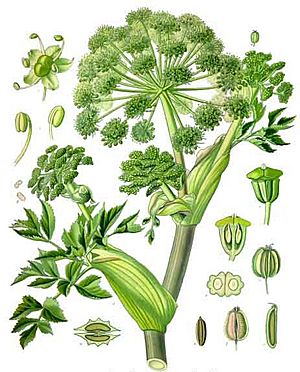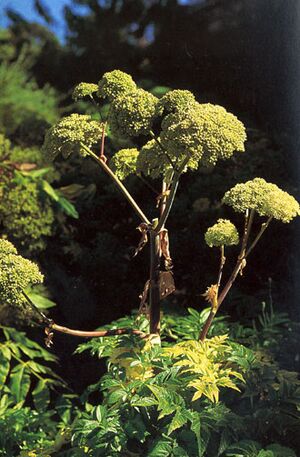Garden Angelica facts for kids
Quick facts for kids Garden angelica |
|
|---|---|
 |
|
| Scientific classification | |
| Synonyms | |
|
Angelica archangelica, often called garden angelica, is a special plant. It is also known as wild celery or Norwegian angelica. This plant lives for two years, which means it is a biennial plant. It belongs to the Apiaceae family, which also includes carrots and parsley.
People grow one type of garden angelica for its sweet-smelling stems and roots. These parts can be eaten. However, some plants in the Apiaceae family look very similar but are poisonous. So, it is super important to be absolutely sure you have identified garden angelica correctly before eating it.
Contents
What Does Garden Angelica Look Like?
In its first year, the garden angelica plant mostly grows leaves. But in its second year, a tall stem grows. This stem can reach up to 2.5 meters (over 8 feet) high! The plant's roots are used to add flavor to foods and drinks.
Its leaves are made of many smaller leaflets. These leaflets are grouped into three main sections, and each section has three smaller groups. The edges of these leaflets have tiny teeth, like a saw.
The flowers bloom in July. They are small and come in many numbers, usually yellowish or greenish. These tiny flowers grow together in big, round clusters called umbels. After the flowers, the plant produces pale yellow, oval-shaped fruits.
Garden angelica loves wet soil. You can often find it growing near rivers or other water sources.
Where Does Garden Angelica Grow?
This plant grows naturally in many northern countries. You can find Angelica archangelica growing wild in Russia, Finland, Sweden, Norway, Denmark, Greenland, the Faroe Islands, and Iceland.
People also grow it in other places. For example, it is farmed in France, especially in a marshy area called the Marais Poitevin. Many angelica plants sold today come from countries like Hungary, Romania, Bulgaria, Germany, and Poland.
How Do People Use Garden Angelica?
People have used angelica for a long time. Since the 900s, it has been grown as a vegetable and a medicinal plant. It became very popular in Scandinavia in the 1100s. The Sami people in northern Europe used it in their cooking. They called it kvanne.
Today, angelica is used to flavor many things. It adds taste to liqueurs and aquavits, which are types of alcoholic drinks. Some famous examples include Chartreuse and Bénédictine. It can also flavor omelettes and trout. People even make jam with it!
The long, bright-green stems of angelica are often candied. This means they are cooked in sugar syrup until they become sweet and chewy. These candied stems are then used to decorate cakes or eaten as a sweet treat.
Angelica has a very special smell. It is different from other plants in its family, like fennel or parsley. Some people say its smell is like musk or juniper. The roots of Angelica archangelica are often used when making gin. They help give gin its unique smell and taste, along with juniper berries. The roots are also used in other drinks like absinthes and bitters.
What Makes Garden Angelica Special?
Scientists study the chemicals inside angelica. These chemicals give the plant its unique smell and flavor. The roots have many special compounds called terpenes. These are what make the plant smell so good.
One interesting compound is called cyclopentadecanolide. Even though there is only a tiny bit of it, it gives angelica roots a special musky smell. This is why perfumers and flavor experts like to use angelica roots.
The seeds of angelica also have similar chemicals. Both the seeds and roots contain coumarins. These are natural compounds that can be found in many plants.
Where Did the Name Come From?
The name Angelica comes from a Latin word meaning "angel-like." People probably gave it this name in the 1500s because of its pleasant smell. The word Archangelica means "an angel of the highest order." This name came from an Old French term in the 1100s, or from the Greek word "arkhangelos," meaning "chief angel."
See also
 In Spanish: Angélica para niños
In Spanish: Angélica para niños




